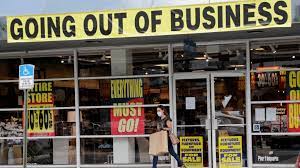Bankrupt Business In Toronto For Sale : 5 Remarkable Opportunities

In the dynamic Bankrupt Business In Toronto For Sale , bankruptcies inevitably occur, presenting both challenges and opportunities for investors and entrepreneurs. Understanding the intricacies of bankrupt businesses for sale is essential in navigating this market. From legal considerations to financial evaluations, this article explores the nuances of acquiring bankrupt businesses in Toronto. By delving into the regulatory frameworks and strategic approaches, readers will gain insights into the potential advantages and pitfalls of investing in such enterprises.
Introduction to Bankrupt Business In Toronto For Sale

Toronto, Canada’s largest city and financial hub, boasts a diverse and vibrant business landscape. As the capital of Ontario, Toronto serves as a focal point for commerce, innovation, and entrepreneurship. The city’s robust economy encompasses various industries, including finance, technology, healthcare, manufacturing, and retail.
The Toronto business market is characterized by its dynamism and competitiveness. Companies ranging from small startups to multinational corporations vie for market share and success in this bustling metropolis. With its strategic location, skilled workforce, and supportive business environment, Toronto attracts investors and entrepreneurs from around the globe.
In recent years, Toronto has experienced fluctuations in its business climate, influenced by factors such as economic trends, regulatory changes, and global events. Despite its resilience, the Toronto business market is not immune to challenges, including economic downturns, market saturation, and disruptive technologies.
Navigating the Toronto business market requires a nuanced understanding of its dynamics and intricacies. Entrepreneurs and investors must stay abreast of market trends, consumer preferences, and regulatory developments to capitalize on opportunities and mitigate risks effectively.
Understanding Bankrupt Business In Toronto For Sale Business Context
Bankruptcy is a legal process through which individuals or entities that are unable to repay their debts seek relief from financial obligations. In the context of the Toronto business market, bankruptcy often signifies the inability of a company to meet its financial obligations and sustain its operations. Understanding the intricacies of bankruptcy is crucial for stakeholders involved in the buying and selling of businesses in Toronto.
- Types of Bankruptcy: In Canada, businesses typically file for bankruptcy under the Bankruptcy and Insolvency Act (BIA) or pursue alternatives such as filing a proposal under the Companies’ Creditors Arrangement Act (CCAA). The BIA provides a framework for insolvent businesses to liquidate assets and distribute proceeds to creditors, while the CCAA allows financially distressed companies to restructure their affairs and avoid bankruptcy through court-supervised proceedings.
- Causes of Business Bankruptcy: Several factors can contribute to business bankruptcy in the Toronto market, including poor financial management, economic downturns, market competition, changing consumer preferences, and unexpected crises such as the COVID-19 pandemic. Understanding the root causes of bankruptcy can help stakeholders identify warning signs and take proactive measures to mitigate financial distress.
- Impact of Bankruptcy: Bankruptcy has far-reaching implications for businesses, creditors, employees, and other stakeholders. For businesses, bankruptcy often results in the liquidation of assets, closure of operations, and loss of reputation. Creditors may experience losses or receive partial repayment of debts depending on the priority of their claims. Employees may face layoffs or job uncertainty as a result of business closures.
- Legal Framework and Procedures: The bankruptcy process in Toronto is governed by federal and provincial legislation, including the BIA, CCAA, and provincial regulations. Licensed insolvency trustees play a crucial role in administering bankruptcies and overseeing the distribution of assets to creditors. The process involves filing bankruptcy documents, liquidating assets, conducting creditor meetings, and obtaining court approvals for restructuring plans.
- Stigma and Perception: Despite efforts to destigmatize bankruptcy, there remains a perception that it signifies failure or mismanagement on the part of businesses. However, bankruptcy is often a strategic decision made to address insurmountable financial challenges and provide a fresh start for debtors. Understanding the nuances of bankruptcy can help dispel misconceptions and foster a more informed approach to financial restructuring.
Identifying Bankrupt Businesses in Toronto

Identifying bankrupt businesses in the Toronto market requires a combination of research, due diligence, and awareness of key indicators. Whether seeking investment opportunities or exploring potential acquisitions, stakeholders must employ effective strategies to identify businesses facing financial distress.
- Public Records and Legal Notices: One of the primary methods for identifying bankrupt businesses in Toronto is through public records and legal notices. The Office of the Superintendent of Bankruptcy Canada maintains a database of bankruptcy filings, which can be accessed online or through designated offices. Legal notices published in newspapers or online platforms may also provide insights into businesses undergoing bankruptcy proceedings.
- Financial Statements and Performance Metrics: Analyzing financial statements and performance metrics can help identify businesses experiencing financial distress. Key indicators of financial distress include declining revenues, increasing debt levels, negative cash flow, and deteriorating profitability. Stakeholders should carefully review balance sheets, income statements, cash flow statements, and other financial documents to assess the financial health of target businesses.
- Market Reputation and Industry Trends: Monitoring market reputation and industry trends can provide valuable insights into the financial stability of businesses in Toronto. Reputation management platforms, industry reports, and market analyses can help assess the reputation and credibility of businesses within their respective industries. Identifying businesses facing negative publicity, customer complaints, or regulatory scrutiny may indicate underlying financial challenges.
- Networking and Industry Connections: Networking with industry professionals, financial advisors, and legal experts can facilitate the identification of bankrupt businesses in Toronto. Attending industry events, conferences, and networking forums allows stakeholders to exchange information, share insights, and collaborate on potential opportunities. Leveraging industry connections and referrals can lead to valuable leads and insider knowledge regarding distressed businesses.
- Legal and Regulatory Filings: Monitoring legal and regulatory filings can provide clues about businesses facing financial distress. Companies may be required to disclose bankruptcy filings, restructuring plans, or creditor arrangements through regulatory filings with government agencies or securities commissions. Analyzing these filings can help stakeholders track the progress of bankruptcy proceedings and assess the potential impact on business operations.
- Consulting Professional Advisors: Engaging professional advisors such as insolvency practitioners, financial analysts, and legal counsel can facilitate the identification of bankrupt businesses in Toronto. Experienced advisors can leverage their expertise, industry knowledge, and network connections to identify distressed businesses, evaluate their financial condition, and assess their viability as investment or acquisition targets.
Evaluating Factors Leading to Bankruptcy
Understanding the factors that contribute to bankruptcy is essential for stakeholders involved in the Toronto business market. By identifying and evaluating these factors, investors, entrepreneurs, and financial professionals can assess the financial health and stability of businesses and mitigate risks associated with bankruptcy.
- Financial Mismanagement: Poor financial management practices, including inadequate budgeting, excessive spending, and misallocation of funds, can contribute to business bankruptcy. Inefficient cost control, lack of financial oversight, and failure to adapt to changing market conditions may exacerbate financial challenges and lead to insolvency.
- Economic Downturns: Economic downturns and recessionary cycles can significantly impact businesses in the Toronto market, leading to declining consumer spending, reduced demand for goods and services, and increased competition. Businesses that are heavily dependent on discretionary spending or vulnerable to fluctuations in economic conditions may struggle to maintain profitability and solvency during periods of economic uncertainty.
- Market Competition: Intense market competition in the Toronto business landscape can pose challenges for businesses seeking to differentiate themselves and capture market share. Competitive pressures, price wars, and disruptive innovations may erode profit margins and undermine the viability of businesses, particularly those operating in saturated or commoditized markets.
- Technological Disruption: Rapid advancements in technology and digital innovation can disrupt traditional business models and render existing products or services obsolete. Businesses that fail to embrace technological change or adapt to evolving consumer preferences risk losing relevance and market competitiveness, leading to financial distress and eventual bankruptcy.
- Legal and Regulatory Compliance: Non-compliance with legal and regulatory requirements can expose businesses to legal liabilities, fines, and penalties, jeopardizing their financial stability and reputation. Failure to adhere to tax obligations, environmental regulations, licensing requirements, and corporate governance standards can result in legal disputes, regulatory enforcement actions, and financial repercussions.
- External Shocks and Crises: External shocks such as natural disasters, geopolitical conflicts, and public health emergencies can disrupt business operations, supply chains, and financial markets, causing widespread economic turmoil and uncertainty. Businesses that are unprepared for unforeseen events or lack contingency plans may struggle to recover from the impact of external crises and face heightened risk of bankruptcy.
- Debt Burden and Financial Obligations: Excessive debt levels, unsustainable financing arrangements, and onerous financial obligations can strain businesses’ cash flow, liquidity, and solvency. High interest rates, restrictive lending terms, and debt covenants may limit businesses’ ability to access capital and refinance existing debt, increasing the likelihood of default and bankruptcy.
- Management and Leadership Issues: Ineffective leadership, poor decision-making, and management conflicts can undermine the stability and performance of businesses in the Toronto market. Weak corporate governance, lack of strategic vision, and management disputes may hinder business operations, impair stakeholder confidence, and precipitate financial distress and bankruptcy.
Legal and Financial Implications of Bankruptcy for Businesses
Bankruptcy proceedings in the Toronto business market carry significant legal and financial implications for businesses, creditors, employees, and other stakeholders involved in the process. Understanding these implications is essential for navigating the complexities of bankruptcy and mitigating potential risks.
- Legal Framework: Bankruptcy proceedings in Toronto are governed by federal legislation, primarily the Bankruptcy and Insolvency Act (BIA), which provides a framework for the administration and resolution of insolvent businesses. The BIA outlines the rights and obligations of debtors, creditors, and other parties involved in bankruptcy proceedings, including the appointment of licensed insolvency trustees, the liquidation of assets, and the distribution of proceeds to creditors.
- Automatic Stay: Upon filing for bankruptcy, businesses are granted an automatic stay, which prohibits creditors from pursuing legal actions or enforcing debt collection efforts against the debtor. The automatic stay provides businesses with temporary relief from creditor harassment and allows for the orderly administration of bankruptcy proceedings under the supervision of the court.
- Asset Liquidation: In bankruptcy proceedings, businesses may be required to liquidate their assets to satisfy outstanding debts and obligations to creditors. Assets may include tangible assets such as inventory, equipment, and real estate, as well as intangible assets such as intellectual property rights and goodwill. The proceeds from asset liquidation are distributed among creditors according to the priority of their claims as specified by the BIA.
- Creditor Claims: Creditors with valid claims against the bankrupt business are entitled to participate in the distribution of proceeds from asset liquidation. The BIA establishes a hierarchy of creditor claims, with secured creditors having priority over unsecured creditors in the distribution of assets. Secured creditors are those with collateral or security interests in specific assets of the debtor, while unsecured creditors have no such security.
- Employee Rights: Bankruptcy proceedings can have significant implications for employees of the bankrupt business. Employees may face layoffs, terminations, or wage reductions as a result of business closures or restructuring efforts. The BIA provides certain protections for employees, including priority status for certain employee-related claims, such as unpaid wages, vacation pay, and severance entitlements.
- Reorganization and Restructuring: In some cases, businesses may pursue reorganization or restructuring alternatives under the BIA or the Companies’ Creditors Arrangement Act (CCAA) to avoid bankruptcy and facilitate a turnaround. Reorganization plans may involve renegotiating debt obligations, selling non-core assets, implementing cost-cutting measures, or seeking new investment capital to stabilize operations and improve financial viability.
- Credit Rating and Reputation: Bankruptcy can have long-term implications for the credit rating and reputation of businesses in the Toronto market. A bankruptcy filing may adversely impact the creditworthiness of the business and its ability to secure financing or enter into future business transactions. Moreover, the stigma associated with bankruptcy may tarnish the reputation of the business and deter customers, suppliers, and investors from engaging with the company in the future.
Assessing the Assets and Liabilities of Bankrupt Businesses

Assessing the assets and liabilities of bankrupt businesses in the Toronto market is a critical step in understanding their financial health, determining their value, and facilitating the resolution of bankruptcy proceedings. By conducting a thorough analysis of assets and liabilities, stakeholders can make informed decisions regarding asset liquidation, creditor claims, and potential acquisition opportunities.
- Inventory of Assets: The first step in assessing the assets of bankrupt businesses involves compiling an inventory of all tangible and intangible assets owned by the company. Tangible assets may include real estate, inventory, equipment, machinery, vehicles, and furniture, while intangible assets may include intellectual property rights, patents, trademarks, and goodwill. Conducting a comprehensive inventory helps identify valuable assets that can be liquidated or transferred to maximize value for creditors.
- Valuation of Assets: Once an inventory of assets is established, stakeholders must determine the fair market value of each asset to assess its worth and potential sale price. Valuation methods may vary depending on the nature of the asset and prevailing market conditions. Common valuation techniques include market-based approaches, income-based approaches, and asset-based approaches. Engaging qualified appraisers or valuation experts can help ensure accurate and reliable asset valuations.
- Identification of Liabilities: In addition to assessing assets, stakeholders must identify and quantify the liabilities of bankrupt businesses, including outstanding debts, accounts payable, loans, leases, and contractual obligations. Liabilities may also include contingent liabilities such as pending lawsuits, legal claims, and warranty obligations. Understanding the extent and nature of liabilities is essential for prioritizing creditor claims and developing strategies for debt repayment or settlement.
- Prioritization of Creditor Claims: Under the Bankruptcy and Insolvency Act (BIA), creditor claims are prioritized based on the type of debt and the security interests held by creditors. Secured creditors, such as lenders with collateral or security interests in specific assets, have priority over unsecured creditors in the distribution of proceeds from asset liquidation. Priority claims, such as employee wages and statutory obligations, are also given precedence over unsecured claims.
- Negotiation and Settlement: Once assets and liabilities have been assessed, stakeholders may engage in negotiations and settlement discussions to resolve creditor claims and finalize bankruptcy proceedings. Negotiating settlements with creditors may involve restructuring debt obligations, offering partial repayment, or transferring assets in satisfaction of debts. Collaborative approaches to debt resolution can help expedite the bankruptcy process and minimize legal disputes.
- Liquidation and Distribution: In cases where bankruptcy proceedings result in the liquidation of assets, stakeholders must oversee the orderly sale and distribution of assets to creditors. Proceeds from asset liquidation are distributed among creditors according to the priority of their claims as determined by the BIA. Liquidation sales may be conducted through public auctions, private sales, or asset disposition firms to maximize returns for creditors and stakeholders.
- Disclosure and Reporting: Throughout the asset assessment and liquidation process, stakeholders must adhere to legal and regulatory requirements regarding disclosure and reporting of financial information. Transparency and accountability are paramount to maintaining the integrity of bankruptcy proceedings and ensuring fair treatment of creditors and stakeholders. Timely and accurate reporting of asset valuations, creditor claims, and distribution of proceeds helps foster trust and confidence among all parties involved.
Bankrupt Business In Toronto For Sale Conclusion
In conclusion, dealing with bankrupt businesses in the Toronto market requires a deep understanding of legal, financial, and operational factors. From spotting warning signs to evaluating causes and assessing assets and liabilities, stakeholders must navigate a complex landscape with care. Transparency, collaboration, and regulatory adherence are crucial due to the legal and financial implications of bankruptcy. By using insights from this exploration, stakeholders can mitigate risks and seize opportunities for restructuring, acquisition, and investment. In Toronto’s dynamic business environment, informed decision-making and strategic planning are key to achieving fair resolutions that protect creditors, employees, and stakeholders, fostering long-term stability and growth.
Frequently Asked Questions (FAQs) about Bankrupt Business In Toronto For Sale
- What is bankruptcy, and how does it affect businesses in Toronto?
- Bankruptcy is a legal process through which businesses unable to repay their debts seek relief from financial obligations. In Toronto, bankruptcy impacts businesses by necessitating asset liquidation, creditor negotiations, and potential closure or restructuring.
- How can stakeholders identify bankrupt businesses in the Toronto market?
- Stakeholders can identify bankrupt businesses in Toronto through public records, legal notices, financial statements, market reputation analysis, networking, and consulting professional advisors.
- What are the common factors leading to bankruptcy for businesses in Toronto?
- Common factors contributing to business bankruptcy in Toronto include financial mismanagement, economic downturns, market competition, technological disruption, legal and regulatory compliance issues, external shocks, debt burden, and management issues.
- What are the legal and financial implications of bankruptcy for businesses and stakeholders?
- Bankruptcy carries significant legal and financial implications, including automatic stays, asset liquidation, creditor claims, employee rights, reorganization, credit rating impact, and reputation damage.
- How are the assets and liabilities of bankrupt businesses assessed in Toronto?
- The assets and liabilities of bankrupt businesses in Toronto are assessed through inventorying assets, valuing assets, identifying liabilities, prioritizing creditor claims, negotiating settlements, overseeing liquidation and distribution, and adhering to disclosure and reporting requirements.
- What strategies can stakeholders employ to navigate bankrupt businesses in Toronto effectively?
- Stakeholders can navigate bankrupt businesses in Toronto by conducting thorough due diligence, seeking professional advice, collaborating with creditors, employees, and other stakeholders, adhering to legal and regulatory standards, and pursuing equitable resolutions that maximize value and promote long-term stability.
- Are there opportunities for investment or acquisition in bankrupt businesses in Toronto?
- Yes, bankrupt businesses in Toronto may present opportunities for investment or acquisition, particularly for investors or entrepreneurs capable of restructuring, revitalizing, or leveraging the assets and resources of distressed businesses for future growth and profitability.
- How can stakeholders protect themselves from the risks associated with bankrupt businesses in Toronto?
- Stakeholders can protect themselves from the risks associated with bankrupt businesses in Toronto by conducting thorough risk assessments, diversifying investment portfolios, implementing risk mitigation strategies, and staying informed about market trends and regulatory developments.
- What are the long-term implications of bankruptcy for businesses and stakeholders in Toronto?
- The long-term implications of bankruptcy for businesses and stakeholders in Toronto may include financial recovery, business reorganization, reputation rehabilitation, creditor relations management, and lessons learned for future business endeavors.
- Where can stakeholders find additional resources and support related to Bankrupt Business In Toronto For Sale ?
- Stakeholders can access additional resources and support related to bankrupt businesses in Toronto through government agencies, industry associations, legal and financial professionals, educational institutions, and online resources offering guidance, training, and networking opportunities.



Leave a Reply
You must be logged in to post a comment.